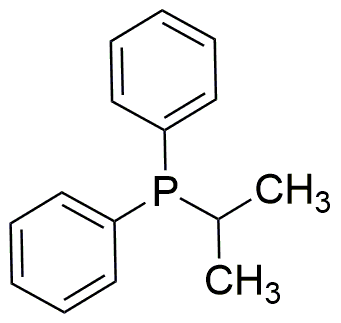Isopropyldiphenylphosphine is widely utilized in research focused on:
- Catalysis: This compound serves as a ligand in various catalytic processes, enhancing the efficiency of reactions in organic synthesis, particularly in the pharmaceutical industry.
- Organometallic Chemistry: It plays a crucial role in the stabilization of metal complexes, which are essential for developing new materials and catalysts.
- Pharmaceutical Development: Researchers use it in drug formulation and development, leveraging its properties to improve the solubility and bioavailability of active pharmaceutical ingredients.
- Analytical Chemistry: Isopropyldiphenylphosphine is employed in the preparation of samples for analytical techniques, aiding in the accurate detection and quantification of various compounds.
- Environmental Applications: It is also explored for its potential in environmental chemistry, particularly in the remediation of pollutants through advanced oxidation processes.
General Information
Properties
Safety and Regulations
Applications
Isopropyldiphenylphosphine is widely utilized in research focused on:
- Catalysis: This compound serves as a ligand in various catalytic processes, enhancing the efficiency of reactions in organic synthesis, particularly in the pharmaceutical industry.
- Organometallic Chemistry: It plays a crucial role in the stabilization of metal complexes, which are essential for developing new materials and catalysts.
- Pharmaceutical Development: Researchers use it in drug formulation and development, leveraging its properties to improve the solubility and bioavailability of active pharmaceutical ingredients.
- Analytical Chemistry: Isopropyldiphenylphosphine is employed in the preparation of samples for analytical techniques, aiding in the accurate detection and quantification of various compounds.
- Environmental Applications: It is also explored for its potential in environmental chemistry, particularly in the remediation of pollutants through advanced oxidation processes.
Documents
Safety Data Sheets (SDS)
The SDS provides comprehensive safety information on handling, storage, and disposal of the product.
Product Specification (PS)
The PS provides a comprehensive breakdown of the product’s properties, including chemical composition, physical state, purity, and storage requirements. It also details acceptable quality ranges and the product's intended applications.
Certificates of Analysis (COA)
Search for Certificates of Analysis (COA) by entering the products Lot Number. Lot and Batch Numbers can be found on a product’s label following the words ‘Lot’ or ‘Batch’.
*Catalog Number
*Lot Number
Certificates Of Origin (COO)
This COO confirms the country where the product was manufactured, and also details the materials and components used in it and whether it is derived from natural, synthetic, or other specific sources. This certificate may be required for customs, trade, and regulatory compliance.
*Catalog Number
*Lot Number
Safety Data Sheets (SDS)
The SDS provides comprehensive safety information on handling, storage, and disposal of the product.
DownloadProduct Specification (PS)
The PS provides a comprehensive breakdown of the product’s properties, including chemical composition, physical state, purity, and storage requirements. It also details acceptable quality ranges and the product's intended applications.
DownloadCertificates of Analysis (COA)
Search for Certificates of Analysis (COA) by entering the products Lot Number. Lot and Batch Numbers can be found on a product’s label following the words ‘Lot’ or ‘Batch’.
*Catalog Number
*Lot Number
Certificates Of Origin (COO)
This COO confirms the country where the product was manufactured, and also details the materials and components used in it and whether it is derived from natural, synthetic, or other specific sources. This certificate may be required for customs, trade, and regulatory compliance.


